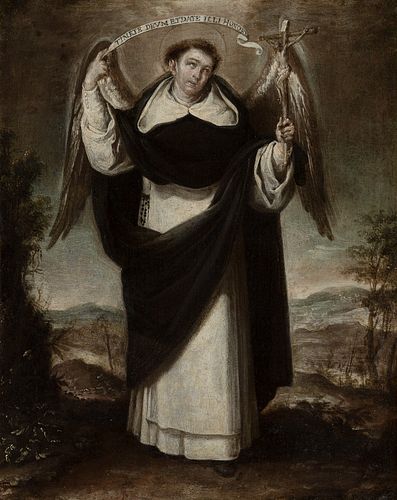Circle of JUAN DE VALDÉS LEAL (Seville, 1622 - 1690) "Saint Thomas Aquinas". Oil on canvas
Lot 73
About Seller
Setdart Auction House
Carrer Aragó 346
Barcelona
Spain
Setdart Subastas was born in 2004 and is currently the first online art auction in Spain with solidity, prestige and reliability guaranteed by our more than 60,000 users. Setdart has a young, dynamic and enterprising team ready to successfully manage the purchase and sale of art works through custom...Read more
Estimate:
EUR€2,500 - EUR€3,000
$2,604.17 - $3,125
Absentee vs Live bid
Two ways to bid:
- Leave a max absentee bid and the platform will bid on your behalf up to your maximum bid during the live auction.
- Bid live during the auction and your bids will be submitted real-time to the auctioneer.
Bid Increments
| Price | Bid Increment |
|---|---|
| EUR€0 | EUR€10 |
| EUR€200 | EUR€25 |
| EUR€500 | EUR€50 |
| EUR€1,000 | EUR€100 |
| EUR€3,000 | EUR€200 |
| EUR€5,000 | EUR€500 |
| EUR€10,000 | EUR€1,000 |
| EUR€20,000 | EUR€2,000 |
| EUR€50,000 | EUR€5,000 |
About Auction
By Setdart Auction House
Oct 20, 2021
Set Reminder
2021-10-20 07:30:00
2021-10-20 07:30:00
America/New_York
Bidsquare
Bidsquare : OLD MASTERS
https://www.bidsquare.com/auctions/setdart-auction-house/old-masters-7700
Setdart Auction House sofia@setdart.com
Setdart Auction House sofia@setdart.com
- Lot Description
Circle of JUAN DE VALDÉS LEAL (Seville, 1622 - 1690) "Saint Thomas Aquinas". Oil on canvas Size: 53 x 42 cm; 63 x 52 (frame). Artist strictly contemporary of Murillo, he was his greatest pictorial rival in the Seville of his time. The comparison between the two painters has been frequent, artificially encouraged by the character of the works of both: if Murillo's was seen as the very expression of gentleness and calm, the harshness and dramatism of Valdés Leal's work and, above all, the extreme truculence of his best known works, the vánitas of the church of La Caridad in Seville, serve to confirm the dichotomy. But, in spite of the difficult character with which he is portrayed in the sources, the truth is that Valdés Leal's work is quite varied and is in line with the painting that was being done in his environment. We do not know at what date he moved to Cordoba, although it is likely that he had already received his first artistic training in his native city. It has been speculated that he was close to the workshop of Herrera el Viejo, and also to the art of the Cordovan Antonio del Castillo, as possible influences for his first known signed and dated work, the San Andrés de la iglesia de San Francisco de Córdoba, from 1647. In it he combined with visible success the monumentality of the figure of the saint with a naturalistic approach. In 1656 he settled in Seville, where he spent most of his life. In 1660 he was one of the founders of the Academy of Drawing, of which he became president in 1663. The following year Palomino established his trip to the court and to El Escorial, a journey that can still be understood as an apprenticeship, driven by his eagerness to know the works of the great masters present in the royal collections. In 1667 he joined the Brotherhood of Charity of Seville, whose founder had been Miguel de Mañara, the noble visionary author of the eschatological Discourse of Truth, to which Valdés would remain attached from then on. In 1671, Valdés Leal had the opportunity to work as an architect on the ephemeral decorations that the cathedral of Seville had installed to celebrate the canonization of Saint Ferdinand. Thanks to these works Palomino defines him as "a great draftsman, perspective and architect". He also made two engravings, reproducing his works in the cathedral, for Fernando Torres Farfán's book celebrating this event, which gives us an insight into his work as an architect. These are his most important works as a printmaker, although his engraving of the cathedral monstrance, a self-portrait and the posthumous image of Miguel de Mañara are also known. In 1672 he was in Cordoba, an occasion that Palomino took advantage of to meet him personally. This gives more value to the affirmation of the Cordovan treatise writer on the literary interest of Valdés Leal, since he makes him possessor of "the ornament of all the good letters, without forgetting those of poetry". Shortly before his death he suffered an illness that prevented him from continuing to work, forcing him to leave the commissions he kept in the hands of his son, a painter in his workshop.
- Shipping Info
-
In-house shipping available. Please inquire at admin@setdart.com.
-
- Buyer's Premium



 EUR
EUR CAD
CAD AUD
AUD GBP
GBP MXN
MXN HKD
HKD CNY
CNY MYR
MYR SEK
SEK SGD
SGD CHF
CHF THB
THB








